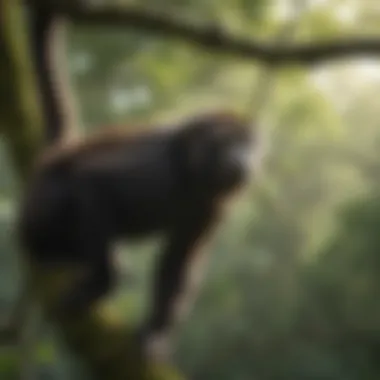Exploring the Diverse Habitats of Howler Monkeys


Nature Topic Overview
Howler monkeys are fascinating creatures, and their habitats are just as captivating. There are many forrests, especially in Central and South America, where howler monkeys make their home. Their living environments are not just random; they are crucial for their survival. In this section, we will look closely at the main factors that determine where howler monkeys thrive, the kinds of forests they prefer, and what influences their habitat choices.
These monkeys are special, as the environment plays a big role in how they live and interact with the world around them. Understanding where howler monkeys reside helps us to learn about their behavior, social structures, and even their diet. By enriching our understanding of their habitats, we also recognize the various challenges they face, including habitat loss and environmental changes.
Fun Facts and Trivia
Here are some recreational points to make the learning experience fun:
- Howler monkeys are the loudest land animals. Their calls can be heard up to three miles away!
- Despite their size, they can leap between branches as far as 30 feet.
- They eat leaves, fruits, and flowers, which are widespread in their bright habitats.
- There are five species of howler monkeys, including the Black Howler and the Mantled Howler.
Integrating visuals or interactive elements, such as picture woodcuts of different habitats or a clickable quiz, can deepen understanding. Young learners can guess which trees howler monkeys more prefer or learn to match which food is found in their habitats.
Wildlife Explorations
The ecosystem around howler monkeys is equally vital. Many other animals inhabit the same forests, like sloths, iguanas, and various birds. This biodiversity makes their living environment special. Knowing more about these creatures helps to appreciate how they cooperate and struggle together.
For example:
- Sloths are slow-moving animals that often hang from branches where howler monkeys also dwell.
- Iguanas can climb and may also feed from the same types of plants the monkeys depend upon.
Every animal plays a role in maintaining the forest's balance. It becomes engaging for children to solve puzzles linking howlers to their associated species by understanding these interactions.
Environmental Awareness
Conservation is vital for howler monkeys. People must work together to protect their habitats, so these monkeys continue to thrive. Preservation efforts can often include:
- Protecting forests to reduce habitat loss.
- Reducing pollution that affects their food supply.
- Creating awareness among communities about the importance of conservation.
Educators can teach young children how they can make small changes to help our forests. They could engage in activities like recycling, conserving water, or attending seminars about local wildlife.
DIY Nature Activities
Hands-on activities can spark interest. Here are some suggestions:
- Create a Forest Map: Kids can draw a map showing where different plants and animals exist, inspired by howler monkeys’ forest homes.
- Birdfeed ers: Involving kids to create simple bird feeders can raise awareness of local foods for howler monkeys.
- Group Nature Walks: Arrange trips to nearby parks to see trees, plants, and animals that are found in their habitats. Binds excitement to the real things discussed above.
These activities encourage an appreciation for nature. They bridge the connection between children and the vibrant lives of howler monkeys.
This exploration uncovers the beautifully intricate relationship that howler monkeys have with their environment, emphasizing why understanding their habitat is essential not only for their existence but also for our shared planet.
Intro to Howler Monkeys
Understanding howler monkeys is crucial for grasping their ecological role and conservation needs. They are not only fascinating creatures but also indicators of forest health. This section introduces the reader to the basic characteristics that define howler monkeys, including their unique vocalizations and social behaviors. By exploring their significance in the ecosystem, one can appreciate why their habitat must be safeguarded.
What are Howler Monkeys?
Howler monkeys belong to the genus Alouatta and are known for their distinctive calls that resonate through the treetops. These primates are large, with bushy tails and strong limbs for navigating forest canopies. They primarily feed on leaves and fruits, showcasing unique adaptations for their herbivorous diet. Their vocalizations can be heard up to three miles away, which helps them communicate across vast distances in dense forests. Through their calls, they establish territory and maintain group cohesion.
Species of Howler Monkeys
There are several species of howler monkeys, each adapted to its specific environment. Some of the notable ones include:
- Black Howler Monkey (Alouatta caraya): This species is found in tropical regions of South America. Its loud roar announces its presence and plays a vital role in social interactions.
- Mantled Howler Monkey (Alouatta palliata): Inhabitants of Central America, these monkeys are easy to identify thanks to the unique mantle of light-colored fur.
- Yellow Howler Monkey (Alouatta belzebul): Native to Brazil, this species has a distinctive yellowish coat, helping it blend into the forest.
Understanding these species helps highlight the relationships between howler monkeys and the habitats they thrive in. The conservation of their environments is crucial for their survival and the overall health of their ecosystems.


Geographical Distribution
Understanding the geographical distribution of howler monkeys is vital for grasping their ecological presence and behavioral patterns. This section examines where these monkeys live across Central and South America, offering insight into the unique environments they inhabit. It also highlights how geographical location influences their survival, community interactions, and conservation needs, thereby underlining the interconnectedness of habitat and species endurance.
Range in Central America
Howler monkeys can be found thriving in various regions in Central America. These locations often entail tropical rainforests, cloud forests, and dry forests. Countries such as Belize, Honduras, Nicaragua, and Costa Rica serve as significant habitats for these monkeys.
- Habitat Diversity: Howler monkeys show a preference for dense foliage, where they can find food and shelter. This habitat is crucial as it provides safety from potential predators and optimal resources for living.
- Adaptability: They demonstrate flexibility in living within both humid areas and drier woodlands. Some species have adapted to reside in urban proximity, where green spaces offer food sources.
The Black Howler Monkey, specifically, is predominantly found in lowland forests in Belize and parts of Honduras. This monkey plays a crucial role in seed dispersal, aiding in the forest regeneration process.
Range in South America
South America presents a vast playground for howler monkeys, with plenty of lush forests to inhabit. Their range extends through countries like Colombia, Venezuela, Ecuador, and Brazil.
- Species Variety: In South America, several species exist. The Brown Howler Monkey flourishes along the Amazon River, showing adaptation to riverine forests, while the Yellow-Horned Howler is essential for its role in biomes suspended between dense woods and relatively clearings.
- Biodiversity Connection: The diverse ecosystems they inhabit promote a balanced food web, maintaining the health of forests where many other species co-exist. Forests in this region, rich in flora and fauna, supply howler monkeys not just food but an environment essential to health and survival.
Notable Habitats
Howler monkeys are residents of extraordinary habitats that allow for a complex social structure and sufficient resources. Their notable habitats encompass:
- Tropical Rainforests: These dense and humid environments are their preferred settings, packed with a variety of trees that provide elements of food and nesting. High biodiversity in these areas assures their nutritional needs are met easily.
- Dry Forests: Specifically during the dry season, howler monkeys adjust to less thick canopies while still finding ample food and water. Species adapt unique strategies to cope with changing climates.
High levels of adaptability several howler monkeys exhibit expand their presence even into mixed-use human areas while still maintaining ecological significance.
- Montane Forests: Some species like the Mantled Howler utilize mountain rainforests. The high elevations feature a cooler climate, where food is plenty, and the terrain is less crowded.
A stronger understanding of their geographical distribution enhances conservation efforts, ensuring that habitats are preserved for future generations to understand the fundamental roles howler monkeys play within their ecosystems.
Types of Habitats
Howler monkeys thrive in distinct habitats that provide them necessary resources for survival. Understanding their habitat types is crucial because it sheds light on what these monkeys require to live healthy lives. Each habitat type has unique characteristics that influence how well howler monkeys can adapt and thrive.
Tropical Rainforests
Tropical rainforests are the best-known habitats for howler monkeys. They offer an ideal environment with a rich diversity of plants and trees.
The canopy in these rainforests is multilayered, creating various habitats numerous animals rely on for food and shelter. Howler monkeys spend a lot of time in trees. They use their strong tails to help balance and move through the branches. Their diet consists mostly of leaves, fruit, and flowers, which are abundant in rainforests. Also, the high humidity and consistent temperatures of these rainforests provide a stable environment.
Tropical rainforests are crucial for howler monkeys, as they deliver food and living space in close proximity.
As further evidence,
- Over half of the world's primate species live in these forests.
- Without these habitats, many would struggle to find the same opportunities.
Dry Forests
Dry forests present a different set of challenges. These areas experience a dry season where food resources might be limited. Despite these difficulties, certain howler monkeys have adapted well to such environments.
These monkeys tend to eat more during the rainy season when the foliage is plentiful. They often lower their activity in dry spells, conserving energy for subsistence. Dry forests often have fewer tree layers compared to rainforests, making mobility more challenging for these monkeys. Though nutrition is paramount, it can fluctuate with the seasons. However, geographically these areas can provide distinct biological communities that support different howler monkey species.
Montane Forests
Montane forests are another habitat howler monkeys occupy. These high-altitude habitats have cooler temperatures and different plant species due to the elevation.
In these regions, howler monkeys may rely more on certain trees that survive the harsh climates. The colder environment also limits some of their usual dietary options. Montane forests can create specific feeding strategies that vary from other habitat types. For instance, the monkeys might consume more bark and tougher leaves when fruits are scarce. The height of the trees allows howler monkeys to see far distances, alerting them to any threats from predators.


Each habitat presents a unique setting for howler monkeys to adjust and move within their world. By analyzing these habitat types, we can better appreciate their ecological and social systems.
Ecological Factors Influencing Habitat Selection
Howler monkeys rely heavily on specific ecological factors when choosing their habitats. Understanding these elements is crucial for grasping their lifestyle and how they interact with the environment. Various components, such as food availability, tree canopy structure, and climate conditions, influence where howler monkeys thrive. Learning about these factors helps connect the dots in how these majestic creatures survive and adapt in their natural surroundings.
Food Availability
The diversity of food sources directly affects howler monkeys' habitat selection. Their diet is primarily vegetarian, focusing on leaves, fruits, and flowers. The availability of these foods in the area determines whether a group of howler monkeys will establish a territory there.
- Leafy Diet: Howler monkeys prefer young leaves due to their higher protein levels. Regions with an abundance of these younger foliage are ideal for their survival.
- Seasonal Fruits: During certain times of the year, fruit becomes scarce. The timing of the fruit's availability impacts the movements of howler monkey groups.
- Tolerance for Poor Quality: Howler monkeys are more immune to lower nutrient density compared to others that rely on richer diets. This will allow them to live in different forest types, like mangroves where not many other species can thrive.
Tree Canopy Structure
The structure of the tree canopy is another critical aspect for howler monkeys. They rely on trees for both food and safety. The ideal tree for howler monkeys should offer a few main features to support their needs:
- Tall Trees: Monkeys access fruits and higher leaves by climbing tall trees. This access is necessary for survival, particularly during food-scarce months.
- Dense Branching: For safety from predators, a dense tree canopy provides cover and makes it complicated for threats to approach.
- Interconnected Canopies: By having a network of trees to jump between, howler monkeys can move freely, maintain social interactions, and find food readily across a habitat area.
“Tree canopy structure is key, where height and density form a shield from dangers and a bridge to food sources.”
Climate Conditions
Climate plays a vital role in habitat selection for howler monkeys. Different climates produce various vegetation types, all of which support specific food sources needed by these primates. Here are the main climatic elements to consider:
- Temperature Range: Howler monkeys prefer warm places, often flourishing in humidity above certain levels. They have limited tolerance for extreme climates, so their presence often indicates suitable temperatures.
- Rainfall Patterns: Heavy consistent rain supports lush vegetation, but extreme seasons can limit access routes for finding food and mates. The natural rainfall pattern needs to coincide with their reproductive cycles for healthy offspring.
- Seasonal Variations: Monkeys alter their habits, including diet, territory, or numbers in a group, by responding to changing seasons. Being well-adapted can determine their fittest chance at survival in shifting environments.
The combination of these ecological factors shapes their habitat suitability, influencing survival and species longevity for howler monkeys. Understanding these elements gives clarity to their existence, which is crucial for their conservation. By maintaining the environments where food is present, tree structures support safety, and climate is conducive, we aim to preserve not just howler monkeys but future diverse ecosystems as well.
Social Structure and Habitat Use
Howler monkeys possess a complex social structure that profoundly impacts their habitat use. Understanding how these social dynamics shape their environments is vital for appreciating their ecology. The social behavior affects their interactions in their habitat, influencing factors like food sources, movement through trees, and how they defend their territory.
Group Dynamics
Howler monkeys often live in groups, typically named troops or bands. These groups can range in size, often consisting of up to fifteen members but can sometimes be larger. Bonding is significant within these groups, creating a stable community essential for survival. Each troop has a structure led by dominant males and females. Dominant individuals mate more frequently and play a crucial role in decision-making, especially regarding where they search for food. The group must communicate well since that affects their foraging strategies.
They use vocalizations, particularly their characteristic howling, to signal their presence to other troops. This alert system helps define their territory and also coordinates group activities. The sound can carry over long distances in the dense forest, ensuring all members remain connected while navigating tall trees for different food sources.
The vocal ability of howler monkeys plays a dual role in their social structure: locational disputes between troops and enhancing group cohesiveness.
Troop cohesion is necessary as it affects protection from predators and increasing foraging efficiency. A well-organized troop can effectively hunt for leaf tips, fruits, and flowers, fulfilling their dietary needs while maintaining a balanced social system.
Territorial Behavior
Howler monkeys exhibit strong territorial instincts. The entirity of their living environment hinges on understanding how and why they defend their territory. Each troop occupies a defined area in their habitat, where they perform feeding, mating, and social interactions. Notably, the localization of food sources greatly determines the boundaries of these territories.
The males of the troops primarily engage in territorial defense. They will vocalize, or howl, to warn other troops to stay away. This announcement not only declares their territory but also minimizes direct confrontations. Their howls carry through the forest, marking the outer bounds of their area and ensuring that nearby troops are aware of their presence.
Important aspects of their territorial behavior include:
- Establishing boundaries to avoid conflicts with neighboring troops.
- Assessing environmental changes, like food availability or habitat destruction, which may resize their territory.
- Interactions with other species, ensuring that their territory can support their needs over time.
Ultimately, the social structure and territorial behavior of howler monkeys intertwine with their habitat use. This interaction not only affects how they survive but also illustrates their ecological significance, particularly concerning forest ecosystems in Central and South America.
Threats to Their Habitat
Deforestation


Deforestation is one of the most significant threats to the habitats of howler monkeys. Trees are cut down for various reasons, including agriculture, logging, and urban development. As forests disappear, howler monkeys lose their natural homes and food sources.
- The loss of trees leads to reduced shelter and nesting sites.
- With fewer food sources, the monkeys must travel further, which adds stress.
- Increased human presence in forests also raises competition for food and exposes howler monkeys to poachers.
This decline in habitat forces howler monkeys into smaller, fragmented areas. It disrupts their social structures and reduces their breeding success, leading to a potential decline in their populations.
Effect on Ecosystem
Deforestation does not just impact howler monkeys; it affects the entire ecosystem. Each tree removed changes the habitat, leading to loss of biodiversity.
It is essential to preserve forests to maintain the delicate balance of life within ecosystems.
Climate Change Impact
Climate change is a pervasive issue that affects the conditions in which howler monkeys live. Changing climate patterns lead to fluctuations in temperature and rainfall. For monkeys that reside in tropical areas, these shifts can be lethal.
- Altered weather patterns can result in less fruit and foliage, impacting food availability.
- Increased temperatures can force howler monkeys to migrate to cooler areas, which may not have the resources they require.
- Extreme weather events such as heavy rainfall or drought can destroy large areas of habitat very quickly, disproportionately affecting vulnerable species.
Research indicates that these climate shifts can lead to significant changes in not just howler monkeys’ capacities to survive but also the entire populations connected with them.
Habitat Fragmentation
Habitat fragmentation occurs when large contiguous habitats are divided into smaller, isolated patches. This divides communities and can range from minor disturbances to major urban developments that separate the forests. Howler monkeys find it difficult to cross these barriers in landscape. This can pose serious challenges:
- Isolated populations may not interbreed, leading to genetic bottlenecks, lowering the overall health of populations.
- Monkeys may lose critical pathways for foraging, leading to increased competition and starvation.
- Fragmented habitats make them more vulnerable to predation.
Conservation Efforts
Conservation efforts play a vital role in protecting howler monkeys and their natural habitats. As the two often connect deeply, understanding the consequences of habitat destruction and environmental changes is important. Protecting these animals requires the involvement of many stakeholders. Governments, local communities, and organizations often work to safeguard the unique environments that howler monkeys depend on for survival.
The most critical aspects of conservation efforts include public awareness, sustainable practices, strenthening laws, and promoting biodiversity. The continuous loss of forests puts these monkeys at risk. Effective conservation strategies are needed not just to support howler monkey populations, but also the countless other species sharing their environments.
Protected Areas
Protected areas are crucial for conserving howler monkeys and their habitats. These areas include national parks, wildlife reserves, and conservation areas where logging, mining, or farming might otherwise disrupt the ecosystem. One significant protected area is the Corcovado National Park in Costa Rica, which provides a refuge for many species including howler monkeys.
Key features of these areas are:
- Protection from human harm: Limits on activities that damage land
- Biodiversity conservation: Seeks to maintain a diverse array of species
- Research opportunities: Scientists can study the natural behavior of howler monkeys Consequently, these locations help in understanding the species and notifying conservation initiatives effectively.
Community Involvement
Community involvement is essential when promoting conservation efforts. Educating local populations about howler monkeys and the dangers they face enhances efforts in sustainable practices. In areas where howler monkeys live, communities play a crucial role.
Sustainable tourism, reforestation projects, and organic farming can all foster healthier environments for these monkeys. Examples of community involvement include:
- Workshops for education about environmental protection
- Involvement in decision-making regarding nearby habitats
- Support in monitoring local biodiversity By fostering a sense of pride in their local wildlife, communities develop a desire to protect the natural world around them. This teamwork encourages long-lasting habits to safeguard the unique ecosystem howler monkeys rely upon.
Without community efforts, conservation strategies may fall short, lacking profound societal support needed for success.
Finale
In reviewing the habitats of howler monkeys, we uncover crucial insights that extend beyond simple ecological facts. Their presence in diverse environments is a key indicator of the health of those habitats. Acknowledging howler monkeys helps us understand the interconnectedness of species and environments. Apointments made towards habitat preservation benefits not merely individual species like howler monkeys but contributes significantly to entire ecosystems. Every little effort counts, whether influenced by scientific or community-led agendas.
Summary of Key Points
To encapsulate the significant aspects highlighted in this article:
- Diverse Habitats: Howler monkeys are adaptable to various habitats including tropical rainforests, dry forests and montane forests. Different trees and climate conditions across these regions support their survival.
- Explore Influence Factors: Food availability, the tree canopy structure and climate conditions drastically influence howler monkeys’ habitat preferences and ultimately their population stability.
- Social Structure Influence Habitats: The social structure among howler monkeys also affects their habitat utilization and overall well-being.
- Threats and Conservation: Habitat threats like deforestation and climate change threaten this species. Conservation efforts, including establishing protected areas, are essential for their survival.
The Importance of Habitat Conservation
The necessity of habitat conservation for howler monkeys cannot be understated. These monkeys contribute vital roles in their ecosystems, such as seed dispersers and indicators of forest health. Protecting their habitats transcends safeguarding just the monkeys themselves. It also secures many other plant and animal species that share their environment. As ecological guardians of rich biodiversity, howler monkeys deserve our respect and intervention. Community involvement plays a crucial role in these conservation efforts. Education regarding these entities sheds light on their needs and fosters public enthusiasm to protect their habitats. Indeed, conserving habitats ensures the sustenance of wildlife for future generations to admire.







